Part 2 of 4
Read full series
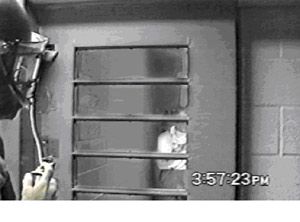 |
The use and effects of OC on individuals and the application of riot control chemical agents on mobs in the streets have been recently addressed in two excellent articles by Dave Young on Corrections1, and one by Steve Ijames on PoliceOne. This article will address the employment of blended agents (CS and OC) and the application of all chemical agents in correctional disturbances and cell extractions.
In 1998, the Los Angeles Sheriff’s Department started replacing personal use OC with a CS/OC blended agent manufactured by Aerko International called Freeze Plus P. We also used the Aerko aerosol grenade, Clearout, as well as Aerko’s handheld Mark IX canister called Deep Freeze. All these products are room temperature aerosols that come out clear and thus do not present visibility or decontamination problems like straight CS agents.
CS is classified as an irritant. The skin exposed to CS feels like it just received an instant sunburn and when inhaled CS causes respiratory distress. Added to the inflammatory effects from OC, this combination is a nice double whammy that has proven far more effective against individuals and large groups than OC alone. The 1999 study by Robert J. Kaminski, Steven M. Edwards, and James W. Johnson on OC’s effectiveness stated that it was approximately 85% effective using the most liberal definition of that term. [See, Assessing the Incapacitative Effects of Pepper Spray During Resistive Encounters With Police, Policing: An International Journal of Police Strategies and Management 22 (1) (1999): 7–29.]
Our experience in Los Angeles indicates that adding CS to OC improves these numbers. There are still situations where because of the physical design of a facility the use of blended agents is not practical and straight OC in large canisters is still employed, however. Also, we have seen inmates suffering from mental illness on who blended agents have not been effective, but for the most part using these products has yielded excellent results.
The LA County Sheriff Department’s cell extraction policy mandates that, except in emergent situations, chemical agents shall be employed prior to using any other less lethal tools. If an inmate consents to being handcuffed and removed after the application of a chemical agent, the situation is determined to be a cell removal and not a cell extraction. For LASD force documentation this is a significant distinction, especially for LASD force documentation purposes.
Since the late 1990s, we have employed a number of different chemical agents including OC Foam, OC in a range of different size canisters and Aerko’s blended agents. By far the blended agents have proven the most effective. Inmates mask up as we do. This affords them some protection against OC, but is of little use against the smaller CS particles. What has proven more effective for them is blocking the doors to the cells themselves and preventing the agent from being introduced.
Ironically, the older facilities with cell bars are far more difficult to barricade against chemicals than newer facilities with hard doors. Modern jails and prisons with hard doors and no cuffing ports are particularly vulnerable, but even those with cuffing ports are susceptible to clever inmates who are well prepared. You will have to try what works best for you.
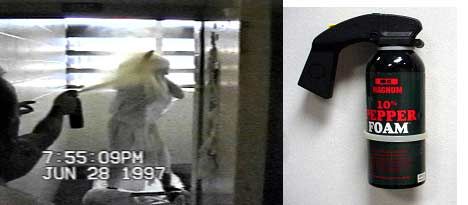 |
OC Foam
The photo above depicts an incident showing LASD’s first use of a MK 9 OC foam canister. This inmate broke out of four point restraints. The foam succeeded in limiting his vision but due to his mental illness did not modify his behavior in any other way. The belief of the deputies was that by using foam there would be no cross contamination so none of them donned gas masks. When the inmate continued his violent behavior a 37mm .32 caliber multi-ball projectile was fired as the team made entry into the cell. All of the deputies ended up coughing on the OC powder that was atomized by the smoke from the black powder in the munition. The effect was not incapacitating for the team, but they did learn a valuable lesson.
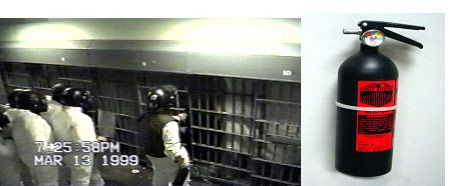 |
Large Canisters of OC
High volume canisters of OC are best used against crowds and in dorm disturbances, but they can be used in cell extractions but only for area treatment. There is a twelve foot stand off distance for direct application on the MK 46 you see being used in the cell extraction above. The concern is that a direct application of the agent to the face might result in hydraulic needling and embed pepper particles in the eye. Though this has never happened, if you spray an inmate in the face with a MK 46, you run that risk. A one second burst from a MK 46 dispenses four ounces of agent. If you choose to use a MK 21 or MK 46 in a cell extraction aim well over the inmate’s head.
Encapsulated Munitions
Both Pepperball launchers and FN 303s can be used on individual targets to deliver kinetic energy, but for the purpose of this article only their application as chemical weapon launching platforms will be discussed. The maximum effective range of a Pepperball launcher for area treatment is 150 feet. The FN 303s maximum effective range against an individual is 50 meters. Though the manufacturer does not have a maximum effective range for area treatment, suffice it to say it is considerably longer than a Pepperball gun. The simple pros and cons between the two platforms as they relate to their use for area treatment are: the FN 303 will give you more range and accuracy, but it has a fifteen round magazine as contrasted with the Pepperball gun that has a hopper that can hold up to 160 rounds; the other big difference is cost. Both the FN 303 and its ammunition are significantly more expensive than Pepperball launchers and rounds.
Though encapsulated munition launchers can be used for area treatment, unlike certain large canisters of aerosol agents, there is no formula to determine how many rounds will be necessary to achieve the desired effect. It is like adding salt to your food; apply to taste. There is a psychological effect caused as rounds go whizzing over inmates’ heads and break against walls and ceilings or begin kicking up clouds of powder around their feet that cannot be matched by aerosol agents. This is one advantage to their use.
When employed in a cell extraction, make sure to fire at the ceiling or against walls significantly over inmates’ heads and let the powder rain down on them. You do not want to accidentally shoot someone in the eye. Used properly, encapsulated munitions can be very effective for you. We have used them with great effect in dorm disturbances and cell extractions in LA County jails for almost eight years.
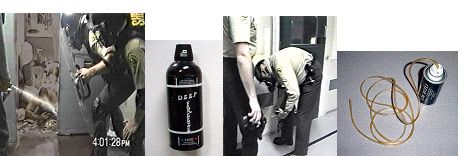 4:01 |
CS/OC Blends
The incident dated 4:01:28 PM (right) shows the direct application of a burst from an Aerko Deep Freeze canister. The inmate being sprayed tried to cut a deputy with a shank through the cuffing port in his cell. This 1998 incident is noteworthy for a couple of reasons. This two-man cell is in a facility that opened in 1995. It has modern air handlers and the ability to vent air directly outside. The inmate who attempted to shank the deputy told his cellmate what to expect based on his previous experience being extracted at Men’s Central Jail, a facility built in 1963 that at the time had extremely limited ability to use blended agents because of air handler issues. The inmate expected OC and used a towel as a mask against it. The blended agent was applied through a tube in the Clearout canister as depicted in the two pictures on the right. The inmate with the shank yelled out, “Death before dishonor,” as soon as the chemical began to be inserted in the cell.
It took about four minutes for dishonor to set in. This is important to note. Regardless of the setting, cell or dorm, you need to give the inmates a few minutes to “cook” in the agent before determining whether it is achieving the desired effect. After four minutes both inmates were both following orders and got down on the ground. At this point neither inmate was yet directly sprayed with the agent. Once the inmates were both stripped down to their boxers and laying on the ground, the sergeant directed that the cell door be opened and ordered the inmates to crawl out.
As soon as fresh air entered the cell the CS effects of the agent began to go away. The inmate hesitated to crawl out and the sergeant ordered that he be sprayed directly. The inmate was quick to crawl out after that. The effects of the blended agent on the inmate who received direct application lasted for almost an hour. His partner who received only area treatment exposure was fine within a matter of a few minutes. Once you leave the chemical environment the incapacitating effects of the blended agent go away rapidly. Inmates must be handcuffed when they are still inside it. If this is not done, they will be ready to fight again. I was part of a cell extraction team where the decision was made not to enter the cell because the inmate flooded it with water. Instead he was permitted to crawl out to the team. Once he left the cell, the fight was on. Go in and get them.
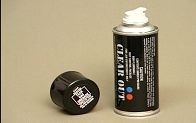 |
Using Aerko’s blended agents in a dorm disturbance also is helpful for another reason. The manufacturer has a very simple formula for determining incapacitation concentration in time (ICT). All you need to know is the volume of the room or dorm where you intend to employ the agent. Length x width x height gives you that number in case you forgot your basic math. Then divide that number by 6,000. That will tell you how many of the 6.5 ounce canisters need to be introduced so that within one minute every inmate in the effected area is experiencing the effects of the agent.
One other thing. There is no need to throw the cans into the area. In fact, this is a bad idea. Inmates will learn quickly that these cans are cold and will cover them up with mattresses or defeat them in some other way. Simply have your personnel hold them in their hands, push down the tops and within twenty-eight seconds the agent will be dispensed. Let the laws of physics work for you. The vapor from the canisters will fill up the space. If you have bars, a sally port, or cuffing or firing ports into the given area, introducing the chemical should not be a problem. In a pinch you can use the MK IX Deep Freeze containers. There is almost three times the amount of agent in these.
What to expect
Remember, when we use any less lethal weapons or chemical agents we are trying to create a tactical break in our adversary’s behavior. If the employment of chemical agents convinces inmates to stop their behavior and follow orders, that’s great, but be prepared to move onto other tactics.
In a dorm disturbance most inmates are waiting for us to do something so they have an excuse to quit fighting. Most participate because if they don’t they will be regulated later by their own. You can introduce chemicals quickly while your team is forming up. This both gives the chemical time to modify the inmates’ behavior and gives you time to put together a better response. Remember, that when large quantities of chemical agents are employed it is imperative to wear a gas mask. Chemical agents are an equal opportunity giver. Supervisors are usually the ones most reluctant to don masks, but though chemicals seem to be only about 85 to 90% effective against bad guys they are just about 100% effective against us.
Read Part 3: The Use of Less Lethal Weapons in Corrections — Electronic Control Devices
About the author
John J. Stanley, M.A., is a twenty-one year veteran of the Los Angeles Sheriff’s Department. He has worked a variety of assignments including, custody, patrol, training and administrative support. He is also a published historian and has written extensively on the history of law enforcement and corrections. He is considered an expert in less lethal weapons and tactics and is currently a member of the TASER International’s Corrections Board. He provided corrections scenarios for the Institute for Non-Lethal Defense Technologies Applied Research Laboratory at Penn State University and contributed to its on-line Less Lethal Weapons class. John spent over a decade at LASD’s Custody Training Unit teaching classes such as Tactical Communications, Jail Intelligence Gathering, Tactical Weapons, Squad Tactics and Cell Extractions. John also was the lead instructor for LASD’s Custody Incident Command School (CICS) a class designed for sergeants and lieutenants and the Executive Incident Command School (EICS) for captains and above. He is also a member of the teaching cadre for LASD’s Tactical Science class offered to police personnel from all over the United States. John is currently a sergeant assigned to the Men’s Central Jail in downtown Los Angeles. He is also a squad leader and trainer on LASD’s newly formed Sheriff’s Response Team (SRT), a unit created to handle crowd control, jail and civil disturbances, and respond to natural disasters and terrorist attacks.











